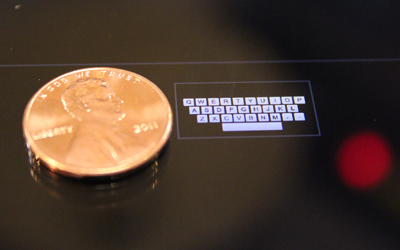Press Release: Carnegie Mellon Researchers Develop Zooming Technique For Entering Text Into Smartwatches, Ultra-small Computers
ZoomBoard Could Help Those with Movement Disorders
Contact: Byron Spice / 412-268-9068 / bspice@cs.cmu.edu
 PITTSBURGH—Technology blogs have been abuzz that smartwatches may soon be on their way from companies such as Apple, Google, Samsung and Microsoft. But as capable as these ultra-small computers may be, how will users enter an address, a name, or a search term into them? One solution is an iterative zooming technique developed and tested by researchers at Carnegie Mellon University.
PITTSBURGH—Technology blogs have been abuzz that smartwatches may soon be on their way from companies such as Apple, Google, Samsung and Microsoft. But as capable as these ultra-small computers may be, how will users enter an address, a name, or a search term into them? One solution is an iterative zooming technique developed and tested by researchers at Carnegie Mellon University.
Called ZoomBoard, this text entry technique is based on the familiar QWERTY keyboard layout. Though the full keyboard is impossibly small on a watch-size display, simply tapping the screen once or twice will enlarge an individual key until it can be comfortably and accurately pressed.
Capital letters can be typed by momentarily holding a key. A swipe to the left deletes a character. A swipe to the right types a space. An upward swipe calls up a secondary keyboard of numbers and other symbols.
"You aren't going to write a novel, but it gets the job done," said Stephen Oney, a Ph.D. student in the Human-Computer Interaction Institute (HCII). "This opens up new possibilities for devices such as smartwatches, which generally lack any means of entering text, as many aren't powerful enough for voice recognition."
"Users can enter about 10 words per minute at high accuracy on a keyboard the size of a penny," said Chris Harrison, a Ph.D. candidate who will soon join the HCII faculty. "That's plenty fast enough to dial a phone number, or enter 'where is pizza?' or get 'directions home.'"
Oney and Harrison developed and evaluated ZoomBoard with fellow HCII students Amy Ogan and Jason Wiese. They will present their findings May 1 at CHI 2013, the Conference on Human Factors in Computing Systems, in Paris, where the research was awarded an honorable mention for Best Paper. A video demonstration and other material is available at the project website, www.chrisharrison.net/index.php/Research/Zoomboard.
"A lot of people are banking on voice for text entry on very small devices, and no doubt voice will play an increasingly central role," Harrison said. "But sometimes you need to enter something discretely and without a big fuss; for that, ZoomBoard is great."
Other approaches to text input on small devices have included new keyboard layouts and gesture-based characters. But the HCII team opted to use the conventional QWERTY keyboard because the configuration is instantly familiar to users.
Further development of ZoomBoard might include a language model, a standard feature on most soft keyboards that suggests possible words based on the first few letters typed; for ZoomBoard, this might also involve adjusting the centering point of the first zoom step over a predicted letter.
The researchers say ZoomBoard also could be useful on larger keyboards for people who have movement disorders that make typing difficult or for people who are using their keyboards while jogging.
The HCII is part of Carnegie Mellon's School of Computer Science. Follow the school on Twitter @SCSatCMU.
###
Called ZoomBoard, this text entry technique is based on the familiar QWERTY keyboard layout. Though the full keyboard is impossibly small on a watch-size display, simply tapping the screen once or twice will enlarge an individual key until it can be comfortably and accurately pressed.